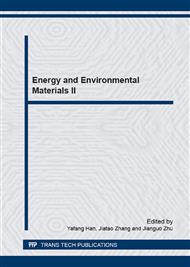[1]
KARAMIŞ M B, ALPER CERIT A, SELÇUK B, et al. The effects of different ceramics size and volume fraction on wear behavior of Al matrix composites for automobile cam material[J]. Wear, 2012, 289: 73–81.
DOI: 10.1016/j.wear.2012.04.012
Google Scholar
[2]
LEE D G, LEE C S, LEE H G, et al. Novel applications of composite structures to robots, machine tools and automobiles[J]. Composite Structures, 2004, 66(1-4): 17–39.
DOI: 10.1016/j.compstruct.2004.04.044
Google Scholar
[3]
FECHNER W. On a composite functional equation satisfied almost everywhere[J]. Indagationes Mathematicae, 2013, 24(1): 103–110.
DOI: 10.1016/j.indag.2012.06.011
Google Scholar
[4]
LEE H S, YEO J S, HONG S H, et al. The fabrication process and mechanical properties of SiCp/Al–Si metal matrix composites for automobile air-conditioner compressor pistons[J]. Journal of Materials Processing Technology, 2001, 113(1-3): 202–208.
DOI: 10.1016/s0924-0136(01)00680-x
Google Scholar
[5]
GOYAL R K, KATKADE S S, MULE D M. Dielectric, mechanical and thermal properties of polymer/BaTiO3 composites for embedded capacitor[J]. Composites Part B: Engineering, 2013, 44(1): 128–132.
DOI: 10.1016/j.compositesb.2012.06.019
Google Scholar
[6]
RAMAJO L, REBOREDO M, CASTRO M. Dielectric response and relaxation phenomena in composites of epoxy resin with BaTiO3 particles[J]. Composites Part A: Applied Science and Manufacturing, 2005, 36(9): 1267–1274.
DOI: 10.1016/j.compositesa.2005.01.026
Google Scholar
[7]
CHO S-D, LEE J-Y, HYUN J-G, et al. Study on epoxy/BaTiO3 composite embedded capacitor films (ECFs) for organic substrate applications[J]. Materials Science and Engineering: B, 2004, 110(3): 233–239.
DOI: 10.1016/j.mseb.2004.01.022
Google Scholar
[8]
ZHANG Z-F, BAI X-F, ZHA J-W, et al. Preparation and dielectric properties of BaTiO3/epoxy nanocomposites for embedded capacitor application[J]. Composites Science and Technology, 2014, 97: 100–105.
DOI: 10.1016/j.compscitech.2014.04.012
Google Scholar
[9]
DANG Z-M, YU Y-F, XU H-P, et al. Study on microstructure and dielectric property of the BaTiO3/epoxy resin composites[J]. Composites Science and Technology, 2008, 68(1): 171–177.
DOI: 10.1016/j.compscitech.2007.05.021
Google Scholar
[10]
JUNG B-H, HWANG S-J, KIM H-S. Glass-ceramic for low temperature co-fired dielectric ceramic materials based on La2O3–B2O3–TiO2 glass with BNT ceramics[J]. Journal of the European Ceramic Society, 2005, 25(13): 3187–3193.
DOI: 10.1016/j.jeurceramsoc.2004.07.002
Google Scholar
[11]
SERBENA F C, ZANOTTO E D. Internal residual stresses in glass-ceramics: A review[J]. Journal of Non-Crystalline Solids, Elsevier B.V., 2012, 358(6-7): 975–984.
DOI: 10.1016/j.jnoncrysol.2012.01.040
Google Scholar
[12]
HSIANG H-I, HSI C-S, HUANG C-C, et al. Sintering behavior and dielectric properties of BaTiO3 ceramics with glass addition for internal capacitor of LTCC[J]. Journal of Alloys and Compounds, 2008, 459(1-2): 307–310.
DOI: 10.1016/j.jallcom.2007.04.218
Google Scholar
[13]
GORZKOWSKI E P, PAN M-J, BENDER B, et al. Crystallization Kinetics of Barium Strontium Titanate Glass-Ceramics[J]. 2006 IEEE International Symposium on the Applications of Ferroelectrics, Ieee, 2006: 21–24.
DOI: 10.1109/isaf.2006.4387823
Google Scholar
[14]
RANGARAJAN B, SHROUE T R, LANAGAN M T. Glass Ceramic Dielectrics : Energy Storage and Breakdown[J]. Science, 2008, 3: 1–2.
Google Scholar
[15]
XUE S, WANG J, LIU S, et al. Effect of the Ba/Na ratio on the microstructure and dielectric properties of (BaO, Na2O)–Nb2O5–SiO2 glass–ceramics[J]. Ceramics International, 2014, 40(5): 7495–7499.
DOI: 10.1016/j.ceramint.2013.12.100
Google Scholar
[16]
DU J, JONES B, LANAGAN M. Preparation and characterization of dielectric glass-ceramics in Na2O–PbO–Nb2O5–SiO2 system[J]. Materials Letters, 2005, 59(22): 2821–2826.
DOI: 10.1016/j.matlet.2005.02.090
Google Scholar
[17]
STOGRYN A. Strong Fluctuation Theory for Moist Granular Media[J]. IEEE Transactions on Geoscience and Remote Sensing, 1985, GE-23(2): 78–83.
DOI: 10.1109/tgrs.1985.289403
Google Scholar
[18]
GRANNAN D, GARLAND J, TANNER D. Critical Behavior of the Dielectric Constant of a Random Composite near the Percolation Threshold[J]. Physical Review Letters, 1981, 46(5): 375–378.
DOI: 10.1103/physrevlett.46.375
Google Scholar
[19]
HAN D F, ZHANG Q M, LUO J, et al. Glass-ceramic nanocomposites in the [(1−x)PbO-xBaO]-Na2O-Nb2O5-SiO2 system: Crystallization and dielectric performance[J]. Solid State Sciences, 2012, 14(6): 661–667.
DOI: 10.1016/j.solidstatesciences.2012.03.009
Google Scholar
[20]
SINGH S, D. A. DRAEGERT, GEUSIC J E. Optical and Ferroelectric Properties of Barium Sodium Niobate[J]. Physical Review. B, 1970, 7(2): 2709–2724.
DOI: 10.1103/physrevb.2.2709
Google Scholar
[21]
PISARSKI M. Effect of hydrostatic-pressure on the dielectric permittivity of NaNbO3 single crystals[J]. Acta Physica Polonica A, 1980, 5(57): 693–698.
Google Scholar
[22]
NEUMAN V, PARRIAUX O, WALPITA L . Double-alkali effect: influence on index profile of ion-exchanged waveguides[J]. Electronics Letters, 1979, 15(22): 704.
DOI: 10.1049/el:19790501
Google Scholar
[23]
PANDA M, SRINIVAS V, THAKUR A K. Percolation behavior of polymer/metal composites on modification of filler[J]. Modern Physics Letters B, 2014, 7(28).
DOI: 10.1142/s0217984914500559
Google Scholar


